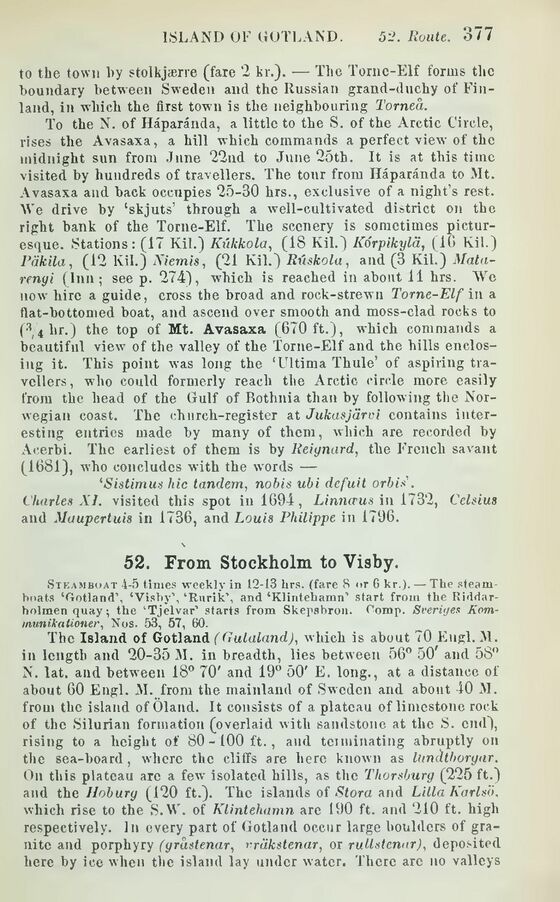
Full resolution (JPEG) - On this page / på denna sida - Sweden - Pages ...

<< prev. page << föreg. sida << >> nästa sida >> next page >>
Below is the raw OCR text
from the above scanned image.
Do you see an error? Proofread the page now!
Här nedan syns maskintolkade texten från faksimilbilden ovan.
Ser du något fel? Korrekturläs sidan nu!
This page has never been proofread. / Denna sida har aldrig korrekturlästs.
to the town by stolkjærre (fare 2 kr.). — The Tornc-Elf forms the
boundary between Sweden and the Russian grand-duchy of
Finland, in which the first town is the neighbouring Torneå.
To the N. of Haparanda, a little to the S. of the Arctic Circle,
rises the Avasaxa, a hill which commands a perfect view of the
midnight sun from June 22nd to June 25th. It is at this time
visited by hundreds of travellers. The tour from Haparanda to Mt.
Avasaxa and back occupies 25-30 hrs., exclusive of a night’s rest.
5Ve drive by ‘skjuts- through a well-cultivated district on the
right bank of the Torne-Elf. The scenery is sometimes
picturesque. Stations: (17 Kil.) Ki’ikkola, (18 Kil.) Korpikylä, (IG Kil.)
Päkila, (12 Kil.) Niemis, (21 Kil.) Ruskola, and (3 Kil.)
Mala-renyi (Inn ; see p. 274), which is reached in about 11 hrs. Wc
now’ hire a guide, cross the broad and rock-strewn Torne-Elf in a
flat-bottomed boat, and ascend over smooth and moss-clad rocks to
(34hr.) the top of Mt. Avasaxa (670 ft.), which commands a
beautiful view of the valley of the Torne-Elf and the hills
enclosing it. This point was long the ‘Ultima Thule’ of aspiring
travellers , who could formerly reach the Arctic circle more easily
from the head of the Gulf of Bothnia than by following the
Norwegian coast. The church-register at Jukasjärvi contains
interesting entries made by many of them, which are recorded by
Acerbi. The earliest of them is by Reiynard, the French savant
(1681), who concludes with the words —
‘Sistimus hie tandem, nobis ubi defuit orbis’.
Charles XI. visited this spot iu 1694, Linncrus in 1732, Celsius
and Maupertuis in 1736, and Louis Philippe in 1796.
52. From Stockholm to Visby.
Steamboat 4-5 times weekly in 12-13 hrs. (fare S or G kr.). — The
steamboats ‘Gotland’, ‘Visby’, ‘Rurik’, and ‘Klintehamn’ start from the
Riddar-holmen quay; the ‘Tjelvar’ starts from Skepshron. Comp. Sveriijes
Kommunikationer, Nos. 53, 57, 60.
The Island of Gotland (Gulaland), which is about 70 Engl. 51.
in length and 20-35 51. in breadth, lies between 56° 50’ and 58°
N. lat. and between 18° 70’ and 19° 50’ E. long., at a distance of
about 60 Engl. 51. from the mainland of Sweden and about 40 51.
from the island of Öland. It consists of a plateau of limestone rock
of the Silurian formation (overlaid with sandstone at the S. end),
rising to a height of 80 -100 ft., and tciminating abruptly on
the sea-board, where the cliffs are here known as Innåthoryar.
On this plateau arc a few isolated hills, as the Thorsburg (225 ft.)
and the Hobury (120 ft.). The islands of Stora and Lilia Karls’6.
which rise to the S.W. of Klintehamn are 190 ft. and 210 ft. high
respectively. In every part of Gotland occur large boulders of
granite and porphyry (yrustenar, rrakstenar, or rullstenar), deposited
here by ice when the island lay under water. There arc no valleys
<< prev. page << föreg. sida << >> nästa sida >> next page >>